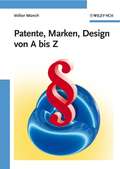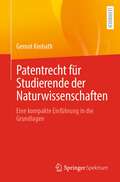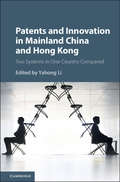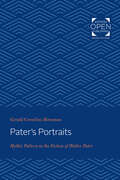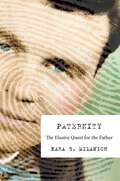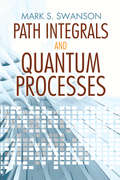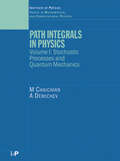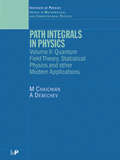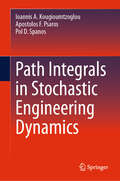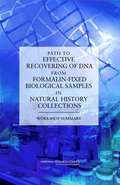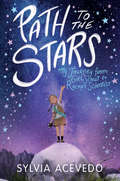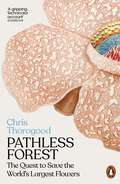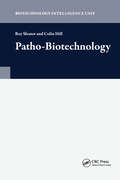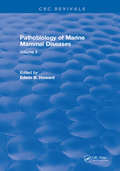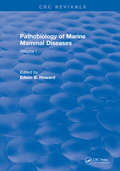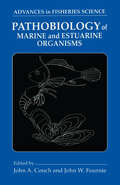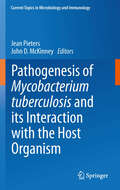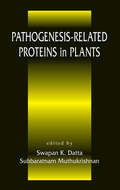- Table View
- List View
Patente, Marken, Design von A bis Z
by Volker MünchPatentrecht, Markenrecht und Designschutz bilden einen Bereich, der standigem Wandel unterworfen ist. Selbst fur Spezialisten ist es zur Herausforderung geworden, Rechte und Forschungsergebnisse zu schutzen in einem internationalen Umfeld, das taglich komplexer wird. Basierend auf dem 1991 erschienenen erfolgreichen Werk "Patentbegriffe von A bis Z" und erganzt um ein dreisprachiges Fachwortverzeichnis, fuhrt das hoch vernetzte Glossar durch den Dschungel der Begrifflichkeiten und berucksichtigt dabei alle aktuellen rechtlichen Anderungen wie: - einheitliche Marken fur die EU - Auswirkung von EU-Richtlinien auf nationale Patentsysteme - EPU ab Dezember 2007 - weltweite Harmonisierung des gewerblichen Rechtsschutzes (TRIPS-Abkommen) inklusive Asien unter besonderer Berucksichtigung Japans - Anderung des US-Patentrechts - Gemeinsamkeiten und Unterschiede des Rechts in verschiedenen Landern Mit eingangigen Beispielen und kompetenten Erklarungen werden Begriffe erlautert, mit denen Erfinder und Patentanmelder am haufigsten konfrontiert werden. Tabellen und Formulare im Anhang geben dem Leser einen Uberblick uber den typischen Lebenslauf einer Anmeldung und helfen ihm, das Zahlen- und Begriffswerk auf den Deckblattern von Patentschriften zu verstehen. Den Umgang mit den entscheidenden Begriffen im nationalen und internationalen Umfeld klart ein Verzeichnis von Fachbegriffen in deutscher, englischer und franzosischer Sprache. Ein absolutes Muss beim Studium der internationalen Literatur - fur Wissenschaftler, Erfinder, Patentanwalte, Dokumentations- und Recherchespezialisten, Ubersetzer, Dolmetscher sowie Studenten und Berufsanfanger auf dem Gebiet des gewerblichen Rechtsschutzes. Mit diesem Buch werden sich Erfinder leicht tun, ihr Patent anzumelden. Kunststoffe Das Buch ist sicher nicht nur Spezialisten zu empfehlen - gerade Studenten und Berufsanfangern durfte es eine gro?e Hilfe sein. Kunststoff-Journal Eine wesentliche Hilfestellung fur potentielle Patentanmelder, was das Werk uber ein reines Worterbuch hinaushebt und tatsachlich sowohl fur Ubersetzer und Dokumentalisten als auch fur Fachleute ein unentbehrliches Hilfsmittel darstellt. TermNet - Jornal of the International Network for Terminology
Patentism Replacing Capitalism: A Prediction from Logical Economics
by Samuel MengBased on economic knowledge and logical reasoning, this book proposes a solution to economic recessions and offers a route for societal change to end capitalism. The author starts with a brief review of the history of economics, and then questions and rejects the trend of recent decades that has seen econometrics replace economic theory. By reviewing the different schools of economic thought and by examining the limitations of existing theories to business cycles and economic growth, the author forms a new theory to explain cyclic economic growth. According to this theory, economic recessions result from innovation scarcity, which in turn results from the flawed design of the patent system. The author suggests a new design for the patent system and envisions that the new design would bring about large economic and societal changes. Under this new patent system, the synergy of the patent and capital markets would ensure that economic recessions could be avoided and that the economy would grow at the highest speed.
Patentrecht für Studierende der Naturwissenschaften: Eine kompakte Einführung in die Grundlagen
by Gernot KrobathDieses Lehrbuch bietet einen kompakten Einstieg in das Patentrecht für Studierende der Naturwissenschaften. Es präsentiert das wesentliche Grundwissen zum deutschen und europäischen Patentrecht. Dabei vertieft sich das Buch bewusst nicht in selten auftretende Spezialfälle oder juristische Feinheiten, sondern es ermöglicht den Lesern, ein Grundverständnis für die zentralen Begriffe und Grundprinzipien des Patentrechts zu entwickeln. Das Lehrbuch enthält zahlreiche Kurzbeispiele und Fallfragen mit Lösungen, anhand derer der Leser die Inhalte verstehen und nachvollziehen kann.
Patents and Innovation in China and Hong Kong: Two Systems in One Country Compared
by Yahong LiHow do patents affect innovation in Mainland China and Hong Kong? How can two patent systems operate within one country and how is innovation affected by the 'one country two systems' model? For the first time, this book links these challenging issues together and provides a comprehensive overview for government officials, law-makers, academics, law practitioners and students to understand the patent systems of Mainland China and Hong Kong. Themes examined include the interaction between the two distinctive patent regimes, the impact of patents on innovation in China's specific industries such as green tech, traditional Chinese medicines and telecommunications, the role of utility models in inflating low-quality patents and the application of good faith principle in enforcing FRAND in Mainland China, patent system reforms in Hong Kong, and the impact of these changes on innovation in the two vastly distinctive yet closely connected jurisdictions.
Pater's Portraits: Mythic Pattern in the Fiction of Walter Pater
by Gerald Cornelius MonsmanOriginally published in 1967. Monsman undertakes a comprehensive critical analysis of Walter Pater's fiction, which presents the critic with numerous causes of frustration, not the least of which is a lack of both dramatic narration and description. Pater is rarely vivid and firsthand in his fiction; he tends instead toward exposition. Monsman's emphasis in Pater's Portraits is "tracing out" the conscious artistic structure of Pater's fiction. The scope of Pater's writings comprises nothing less than Western culture itself; its subject is all that man has written, thought, said, sung, hoped, or prayed as a civilized creature over two and one-half millennia. Pater's success in handling such panoply is attributable to his discovery of a coherent pattern by which art, religion, and life can be organized. Monsman aims to discover in Pater's fiction the use of old scientific-religious patterns of myth to explain moments of religious and cultural awakening, to reveal the way in which one man arrived at a credo that would answer to the desolation of life and culture.
Paternity: The Elusive Quest for the Father
by Nara B. MilanichFor most of human history, paternity was uncertain. Blood types, fingerprinting, and, recently, DNA analysis promised to solve the riddle of paternity. But even genetic certainty did not end the quest for the father. Rather, as Nara Milanich reveals, it confirms the social, cultural, and political nature of the age-old question: Who’s your father?
Path Integrals and Quantum Processes (Dover Books on Physics)
by Mark S. SwansonThis graduate-level text offers a systematic presentation of the path integral approach to calculating transition elements, partition functions, and source functionals. Topics include Grassmann variables, field and gauge field theory, perturbation theory, and nonperturbative results. Requires only some familiarity with quantum mechanics. Numerous exercises. Ideal as course supplement or for independent study. 1992 edition.
Path Integrals in Physics: Volume I Stochastic Processes and Quantum Mechanics
by M Chaichian A DemichevPath Integrals in Physics: Volume I, Stochastic Processes and Quantum Mechanics presents the fundamentals of path integrals, both the Wiener and Feynman type, and their many applications in physics. Accessible to a broad community of theoretical physicists, the book deals with systems possessing a infinite number of degrees in freedom. It discusses the general physical background and concepts of the path integral approach used, followed by a detailed presentation of the most typical and important applications as well as problems with either their solutions or hints how to solve them. It describes in detail various applications, including systems with Grassmann variables. Each chapter is self-contained and can be considered as an independent textbook. The book provides a comprehensive, detailed, and systematic account of the subject suitable for both students and experienced researchers.
Path Integrals in Physics: Volume II Quantum Field Theory, Statistical Physics and other Modern Applications
by M Chaichian A DemichevThe path integral approach has proved extremely useful for the understanding of the most complex problems in quantum field theory, cosmology, and condensed matter physics. Path Integrals in Physics: Volume II, Quantum Field Theory, Statistical Physics and other Modern Applications covers the fundamentals of path integrals, both the Wiener and Feynman types, and their many applications in physics. The book deals with systems that have an infinite number of degrees of freedom. It discusses the general physical background and concepts of the path integral approach used, followed by a detailed presentation of the most typical and important applications as well as problems with either their solutions or hints how to solve them. Each chapter is self-contained and can be considered as an independent textbook. It provides a comprehensive, detailed, and systematic account of the subject suitable for both students and experienced researchers.
Path Integrals in Stochastic Engineering Dynamics
by Ioannis A. Kougioumtzoglou Pol D. Spanos Apostolos F. PsarosThis book organizes and explains, in a systematic and pedagogically effective manner, recent advances in path integral solution techniques with applications in stochastic engineering dynamics. It fills a gap in the literature by introducing to the engineering mechanics community, for the first time in the form of a book, the Wiener path integral as a potent uncertainty quantification tool. Since the path integral flourished within the realm of quantum mechanics and theoretical physics applications, most books on the topic have focused on the complex-valued Feynman integral with only few exceptions, which present path integrals from a stochastic processes perspective. Remarkably, there are only few papers, and no books, dedicated to path integral as a solution technique in stochastic engineering dynamics. Summarizing recently developed techniques, this volume is ideal for engineering analysts interested in further establishing path integrals as an alternative potent conceptual and computational vehicle in stochastic engineering dynamics.
Path To Effective Recovering Of Dna From Formalin-fixed Biological Samples In Natural History Collections: Workshop Summary
by National Research Council of the National AcademiesThe National Academies Press (NAP)--publisher for the National Academies--publishes more than 200 books a year offering the most authoritative views, definitive information, and groundbreaking recommendations on a wide range of topics in science, engineering, and health. Our books are unique in that they are authored by the nation's leading experts in every scientific field.
Path to the Stars: My Journey from Girl Scout to Rocket Scientist
by Sylvia AcevedoThe inspiring memoir for young readers about a Latina rocket scientist whose early life was transformed by joining the Girl Scouts and who currently serves as CEO of the Girl Scouts of the USA.A meningitis outbreak in their underprivileged neighborhood left Sylvia Acevedo’s family forever altered. As she struggled in the aftermath of loss, young Sylvia’s life transformed when she joined the Brownies. The Girl Scouts taught her how to take control of her world and nourished her love of numbers and science. With new confidence, Sylvia navigated shifting cultural expectations at school and at home, forging her own trail to become one of the first Latinx to graduate with a master's in engineering from Stanford University and going on to become a rocket scientist at NASA’s Jet Propulsion Laboratory. Simultaneously available in Spanish!
Pathless Forest: The Quest to Save the World’s Largest Flowers
by Dr Chris ThorogoodThe incredible story of one man's obsession to find and protect the world's largest flowers As a child, Chris Thorogood dreamed of seeing Rafflesia - the plant with the world's largest flowers. He crafted life-size replicas in an abandoned cemetery, carefully bringing them to life with paper and paint. Today he is a botanist at the University of Oxford's Botanic Garden and has dedicated his life to studying the biology of such extraordinary plants, working alongside botanists and foresters in Southeast Asia to document these huge, mysterious blooms.Pathless Forest is the story of his journey to study and protect this remarkable plant - a biological enigma, still little understood, which invades vines as a leafless parasite and steals its food from them. We join him on a mind-bending adventure, as he faces a seemingly impenetrable barrier of weird, wonderful and sometimes fearsome flora; finds himself smacking off leeches, hanging off vines, wading through rivers; and following indigenous tribes into remote, untrodden rainforests in search of Rafflesia's ghostly, foul-smelling blooms, more than a metre across.We depend on plants for our very existence, but two in five of the world's species are threatened with extinction - nobody knows how many species of Rafflesia might already have disappeared through deforestation. Pathless Forest is part thrilling adventure story and part an inspirational call to action to safeguard a fast-disappearing wilderness. To view plants in a different way, as vital for our own future as for that of the planet we share. And to see if Rafflesia itself can be saved.
Patho-Biotechnology
by Colin Hill Roy SleatorIn 2006, the termPatho-biotechnology' was coined to describe the exploitation of pathogens, or pathogen derived factors, for beneficial applications in biotechnology, food and medicine.This concept encompasses three broad areas:i. The first approach (outlined in Chapters 1-10) involves the use of selected pathogens as effective prophylactic and/o
Patho-Epigenetics of Infectious Disease
by Hans Helmut Niller Janos MinarovitsEpigenetic modification of cellular genomes is a fascinating means of regulating tissue- and cell type-specific gene expression in all developmental stages of the life of an organism. Carefully orchestrated processes, such as DNA methylation and a plenitude of specific histone modifications secure the faithful transmission of gene expression patterns to progeny cells. Upon chronic infection, the epigenetic cellular balance can become disrupted and, in the long run, through the epigenetic reprogramming of host cell genomes, contribute to the malignant conversion of formerly healthy cells, in many cases preceded by the establishment of an epigenetic field of cancerization. The present volume undertakes to highlight the interactions of infectious pathogens and their effector molecules with the epigenetic regulatory machinery of the cell. Clearly, the recent take-off of epigenetics research did not leave Research on Infectious Diseases and Infection-Associated Cancer untouched. This resulted in a great many of clinically relevant data on understanding the molecular mechanisms of chronic infectious disease. Infectious pathogen- and disease-specific epigenetic alterations are already being used for the early detection of malignant disease and for the prediction of chemotherapy resistance or response to treatment.
Pathobiology Of Marine Mammal Diseases: Volume I
by HowardThese volumes provide information which will be helpful to comparative pathologists, veterinarians, and all marine scientists and other individuals who are interested in the study of marine mammals, and the diseases they develop in both their feral and captive environment.This publication is a reflection of the observations of the various authors, some of whom have pioneered in this field, and is an attempt to update the available information concerning the natural diseases, and the corresponding pathologic changes in marine mammals.
Pathobiology Of Marine Mammal Diseases: Volume II
by Edwin B. HowardThese volumes provide information which will be helpful to comparative pathologists, veterinarians, and all marine scientists and other individuals who are interested in the study of marine mammals, and the diseases they develop in both their feral and captive environment.This publication is a reflection of the observations of the various authors, some of whom have pioneered in this field, and is an attempt to update the available information concerning the natural diseases, and the corresponding pathologic changes in marine mammals.
Pathobiology of Marine and Estuarine Organisms (Advances In Fisheries Science Ser.)
by John A. Couch; John W. FourniePathobiology of Marine and Estuarine Organisms is a comprehensive, up-to-date review of aquatic animal pathobiology covering infectious and non-infectious diseases of vertebrates such as marine mammals and fishes, in addition to diseases of invertebrates such as crustacea, mollusks, and lower phyla. The book provides critical information on viral, fungal, bacterial, parasitic, and neoplastic diseases of fish and invertebrates. Written by top-notch experts in the field, Pathobiology of Marine and Estuarine Organisms emphasizes pollution-associated diseases and includes an important review on the effects of pollution on marine mammals. The book will be a welcome addition to the libraries of aquatic and marine biologists, aquatic toxicologists, fisheries biologists, aquaculturalists, fish and invertebrate pathologists, and aquatic animal parasitologists.
Pathogen removal in aerobic granular sludge treatment systems (IHE Delft PhD Thesis Series)
by Mary Luz Barrios HernàndezThis book describes pathogen removal processes in aerobic granular sludge (AGS) wastewater treatment systems. Faecal indicators (E. coli, Enterococci, coliforms and bacteriophages) were tracked in full-scale AGS facilities and compared to parallel activated sludge (CAS) systems. AGS showed similar removals as the more complex CAS configurations. Removal mechanisms investigated in laboratory-scale reactors showed that the AGS morphology contributes to the removal processes. By tracking E. coli and MS2, it was observed that organisms not attached to the granules are predated by protozoa during aeration. 18S RNA gene analyses confirmed the occurrence of bacterivorous organisms (e.g., Epistylis, Vorticella, Rhogostoma) in the system. Particulate material in the feeding stimulated their development, and a protozoa bloom arose when co-treating with (synthetic) faecal sludge (4 % v/v). An overview of the diverse eukaryotic community in laboratory reactors and real-life applications is also provided. The microbial diversity of the influent was different compared to AGS and CAS sludge samples. However, no clear differences were found between them on species level. This study contributes to a better understanding of the mechanisms behind pathogen removals in AGS systems.
Pathogenesis of Mycobacterium tuberculosis and its Interaction with the Host Organism
by Jean Pieters John D. MckinneyMycobacterium tuberculosis is one of the most notorious pathogens on earth, causing the death of approximately 1. 5 million people annually. A major problem in the fight against tuberculosis is the emergence of strains that have acquired resistance to all available antibiotics. One key to the success of M. tuberculosis as a pathogen is its ability to circumvent host immune responses at different levels. This is not only a result of the special makeup of M. tuberculosis in terms of genetic diversity and DNA metabolism and its possession of specialized secretion systems, but also of its ability to hijack the host's innate immune defence mechanisms. In this volume, researchers from different disciplines provide a topical overview of the diverse mechanisms that contribute to the virulence of M. tuberculosis, ranging from their genetic, metabolic and molecular makeup, as well as the complex strategies these bacteria utilize to escape immune destruction within infected hosts.
Pathogenesis of Systemic Lupus Erythematosus: Insights from Translational Research
by Alberta HoiThe scope of this contributed volume is to provide an overview of the latest translational research in the field of lupus pathogenesis, with particular emphasis on how these discoveries progress in parallel with therapeutic drug development. Systemic lupus erythematosus (SLE) is a multifaceted disease with a number of well-defined immune pathways that are dysregulated, resulting in an immune-mediated chronic inflammatory injury at target organs. As knowledge of these pathways evolves to provide opportunities for targeted drug therapy and lays the foundation for personalized medicine, clinicians and researchers need to keep up with the ever-expanding medical literature.This book will critically appraise the current understanding of important immunological pathways that contribute to the pathogenesis of lupus. We will review the role of interferons as part of the innate immune defects that perpetuate the loss of self-tolerance in SLE. B cell hyperactivity, as a defining hallmark of SLE, and different strategies of B cell targeted therapy will be discussed. The role of co-stimulation or immune checkpoint molecules in activating B and T cells will be reviewed, as well as other cytokines that serve in the amplification loop promoting a more proinflammatory Th1 or Th17 responses. Intracellular targets, such as signaling molecules in the JAK/STAT pathway, or a variety of kinases and proteasomes, can cause a cascading downstream effect of transcriptional responses that are important in SLE. Immune homeostasis can also be restored by bolstering the naturally occurring anti-inflammatory mechanisms. Glucocorticoid, as a potent natural anti-inflammatory hormone, can mediate its effects by recruiting histone deacetylase that serve to repress gene transcription. Glucocorticoid-induced leucine zipper is a gene upregulated by glucocorticoid that can be a potential target for development of anti-inflammatory strategy. Finally, T regulatory cells can be utilized to help restore to immune tolerance and are amongst the latest focus of therapeutic development in SLE.
Pathogenesis-Related Proteins in Plants
by Swapan K. Datta Subbaratnam MuthukrishnanA great deal of research has been focused on the isolation, characterization, and regulation of expression of pathogenesis-related proteins since the discovery that several of the PR-proteins had antimicrobial or insecticidal activity and can delay the progression of diseases caused by several pathogens belonging to diverse genera. This is an excit
Pathogenic Fungi in Humans and Animals
by Dexter H. HowardExploring breakthroughs in fungal detection and control, this book covers fungal nomenclature, population instability, and phylogeny, as well as investigative research on Peronosporomycetes, Zygomycetes, Filamentous Ascomycetes, Basidiomycetous Yeasts, Endomycetes and Blastomycetes, and Miscellaneous Opportunistic Fungi. It offers methods to identi
Pathogenic Yeasts
by Ruth Ashbee Elaine M. BignellMycological studies of yeasts are entering a new phase, with the sequencing of multiple fungal genomes informing our understanding of their ability to cause disease and interact with the host. At the same time, the ongoing use of traditional methods in many clinical mycology laboratories continues to provide information for the diagnosis and treatment of patients. This volume reviews various aspects of pathogenic yeasts and what is known about their molecular and cellular biology and virulence, in addition to looking at clinical and laboratory findings. As each chapter is written by a leading expert in the field, this book summarizes in one volume much of the latest research on several pathogenic yeasts, including Candida, Cryptococcus, Malassezia and yeasts of emerging importance. The importance of laboratory diagnosis, antifungal susceptibility testing, antifungal resistance and yeast diseases in animals are reviewed.
Pathogenic Yersinia: Methods and Protocols (Methods in Molecular Biology #2010)
by Viveka Vadyvaloo Matthew B. LawrenzThis volume delivers a compendium of detailed protocols to the research community in order to aid in the investigation and discovery of Yersinia virulence mechanisms using important in vivo and in vitro infection models, which have led to major advances in the field and in our understanding of Yersinia pathogen-host interactions. Beginning with a section on mouse models, the book continues with chapters covering the monitoring of bacteria during infection, invertebrate models, as well as Yersinia interaction with immune cells and immune signaling. Written for the highly successful Methods in Molecular Biology series, chapters include introductions to their respective topics, lists of the necessary materials and reagents, step-by-step, readily reproducible protocols, and tips on troubleshooting and avoiding known pitfalls. Comprehensive and authoritative, Pathogenic Yersinia: Methods and Protocols provides a single source for researchers seeking to better understand these pathogens and the diseases they produce in humans.
